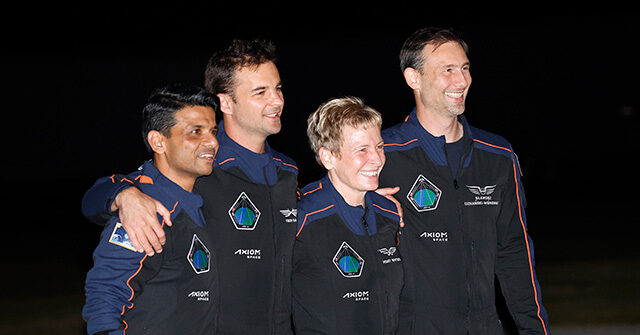Astronauts from India, Poland, and Hungary were on board when Axiom Mission 4 launched from the Kennedy Space Center in Florida on Wednesday, bound for the International Space Station (ISS).
The mission marks the first time those three countries have put crewmembers in space.
In fact, no one aboard the spacecraft – including U.S. mission commander Peggy Whitson – had been born the last time an Indian, Polish, or Hungarian astronaut made orbit. Their last space missions took place in the 1980s as cosmonauts for the defunct Soviet Union.
The leaders of India, Poland, and Hungary were very excited about their returns to space:
India’s astronaut is Group Captain Shubhanshu Shukla, an Indian Air Force test pilot. He is one of four candidates selected last year to potentially helm India’s first-ever domestic human space flight, called the Gaganyaan Mission, currently scheduled for 2027.
India’s ambitious space agenda includes plans for a space station by 2035 and a Moon landing by 2040. Hungary is a partner in India’s space program, known as the India Space Congress.
“India is no longer a follower but an equal partner. Shubhanshu Shukla, the Indian member of the crew, is going to be the most crucial component of this entire mission, which is going to last about two weeks,” Indian Science and Technology Minister Jitendra Singh told reporters on Wednesday.
“Who knows how many future Polish astronauts were watching Slawosz’s launch with me? Everyone was very excited and very proud!” said Tusk’s message, accompanied by a photo of himself watching the launch with a crowd of children from Warsaw’s Copernicus Science Center. The Polish member of the crew is mission specialist Slawosz Uznanski-Wisniewski, an engineer with the European Space Agency (ESA) and a former project leader for the European Organization for Nuclear Research (CERN).
“The sky is the limit. A Hungarian is in space again. Go, Tibor Kapu!” Hungarian Prime Minister Viktor Orban wrote on his Facebook page.
Kapu is a research astronaut who was selected for the mission by HUNOR, the Hungarian to Orbit program, which was launched in 2021. He sent a live message from the launch pad in which he said, “Fifteen million Hungarians lifted me to this moment. Your support is like an ember under gray ash: glowing quietly, but ready to blaze when the spark is lit.”
Kapu’s carry-on luggage included a teddy bear in a cosmonaut suit, which also rode into space with Hungary’s first astronaut, Bertalan Farkas. Farkas is still alive and was on hand at the Kennedy Space Center to cheer Kapu’s flight. He said it was “one of the most important moments” in his life.
Uznanski-Wisniewski also carried a token from a predecessor, a Polish flag that once adorned the spacesuit of astronaut Miroslaw Hermaszekshi, who died in 2022.
Shukla said his mentor Rakesh Sharma, India’s first astronaut, could not attend the launch in Florida, but he was carrying a “surprise gift” to honor his predecessor. Shukla was born one year after Sharma went into space aboard a Russian Soyuz craft.
The two-week Axiom 4 mission is a private endeavor co-funded by India, Poland, and Hungary. The mission was put together by a company called Axiom Space in Houston. The launch vehicle was a Falcon 9 rocket built by Elon Musk’s SpaceX. Mission commander Peggy Whitson is a former NASA astronaut with a record 675 days of experience in spaceflight who is now employed by Axiom Space. The crew members were ferried to their spacecraft by electric SUVs from Musk’s Tesla automobile company.
The Axiom 4 mission was delayed for several weeks after a public disagreement between Musk and President Donald Trump over Trump’s “Big Beautiful Bill.” Musk harshly criticized the bill for not doing enough to cut the wasteful spending he found when he was working with the Department of Government Efficiency (DOGE).
Musk threatened to decommission the ISS transports after Trump said he might cancel SpaceX’s billions of dollars in contracts with the U.S. government. The feud between the two eventually subsided and Musk later said some of his comments about Trump “went too far.”
The Axiom-4 astronauts are traveling aboard a Crew Dragon space capsule, the fifth of its kind. The crew has traditionally named the Crew Dragons after liftoff. The Axiom 4 team chose the name “Grace.” The four earlier craft are named Endeavor, Resilience, Endurance, and Freedom.
“Grace is more than a name. It reflects the elegance with which we move through space against the backdrop of Earth. It speaks to the refinement of our mission, the harmony of science and spirit and the unmerited favor we carry with humility,” Whitson said from the sky after what she described as an “incredible ride uphill” on Wednesday.
“Grace reminds us that spaceflight is not just a seed of engineering, but an act of good work for the benefit of every human everywhere,” she said.
Grace is also scheduled to be the last of the Crew Dragons, as SpaceX plans to introduce the next-generation Starship rocket in the 2030s. According to SpaceX, the fully reusable Starship will be the “most powerful launch vehicle ever developed.”
After spending the better part of a day catching up to the International Space Station in orbit, the Axiom-4 team will spend 14 days aboard the ISS in the company of its current long-term crew, which includes three NASA astronauts, three Russian cosmonauts, and a member of JAXA, the Japan Aerospace Exploration Agency. The mission plan includes 60 experiments to be performed in orbit.
The return trip for Axiom 4, to be conducted sometime in July depending on weather conditions, will end with a splashdown off the West Coast of the United States.
Dragon missions originally came down off the Florida coast, but the flight plan was changed after some debris from a mission survived re-entry and fell in the mountains of North Carolina in May 2024. A few local residents were surprised to find space debris in their backyards. One of them investigated through the time-honored method of poking the mysterious object from outer space with a stick.


















